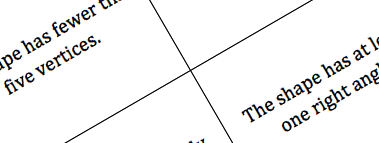Copyright © University of Cambridge. All rights reserved.
'What Am I?' printed from https://nrich.maths.org/
Show menu
Why do this problem?
This activity will help to consolidate learners' understanding of properties of 2D shapes. In order to tackle the problem, they will be comparing different 2D shapes, whether this be by visualising, by drawing, or using practical resources. It could be a useful assessment task.
Possible approach
Give pairs or small groups copies of the cards and simply explain that their task is to draw the shape that is being described. Try not to say anything more at this stage. Stand back and observe the children as they begin the task.
As you move around the room, watch out for those who have an organised approach. Perhaps they are discussing each card in turn and agreeing what it tells them. Perhaps they have noticed some cards which together help narrow down the possibilities. Bring the class together to share thoughts so far (a mini-plenary) which will help some children 'get off the ground' and
others by giving them chance to articulate their ideas.
Having given more time for them to complete the task, the plenary could focus on whether all the information was needed. Were there any cards that were superfluous? Which ones? Why?
Key questions
What does this card tell you about the shape?
What do we know now?
How are you keeping track of what you know so far?
Possible extension
Some learners might relish the challenge of creating their own version of this task. You may wish to stipulate that there must be one solution, or perhaps you'd like them to create a task which has two or more possible outcomes. Of course, once a new activity is completed it must be tried out!
Possible support
You could give some children a sheet with some possible shapes on it, one of which is the solution. That way, the task becomes one which involves only comparing and contrasting, rather than creating.
